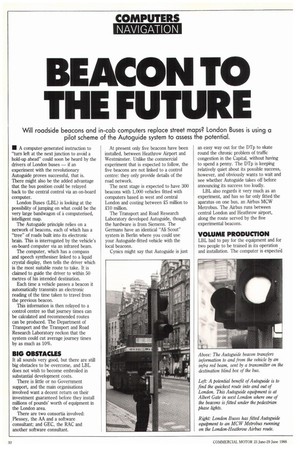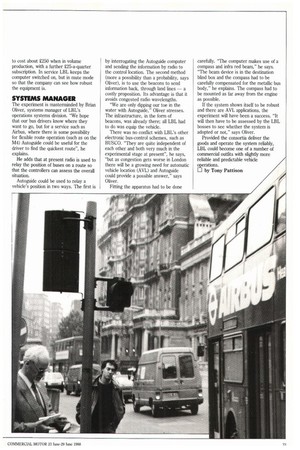BEACON TO THE FUTURE
Page 34

Page 35

If you've noticed an error in this article please click here to report it so we can fix it.
Will roadside beacons and in-cab computers replace street maps? London Buses is using a pilot scheme of the Autoguide system to assess the potential.
• A computer-generated instruction to "turn left at the next junction to avoid a hold-up ahead" could soon be heard by the drivers of London buses — if an experiment with the revolutionary Autoguide proves successful, that is There might also be the added advantage that the bus position could be relayed back to the central control via an on-board computer.
London Buses (LBL) is looking at the possibility of jumping on what could be the very large bandwagon of a computerised, intelligent map.
The Autoguide principle relies on a network of beacons, each of which has a "tree" of roads built into its electronic brain. This is interrogated by the vehicle's on-board computer via an infrared beam.
The computer, which has a compass and speech synthesiser linked to a liquid crystal display, then tells the driver which is the most suitable route to take. It is claimed to guide the driver to within 50 metres of his intended destination.
Each time a vehicle passes a beacon it automatically transmits an electronic reading of the time taken to travel from the previous beacon.
This information is then relayed to a control centre so that journey times can be calculated and recommended routes can be produced. The Department of Transport and the Transport and Road Research Laboratory reckon that the system could cut average journey times by as much as 10%.
BIG OBSTACLES
It all sounds very good, but there are still big obstacles to be overcome, and LBL does not wish to become embroiled in substantial development costs.
There is little or no Government support, and the main organisations involved want a decent return on their investment guaranteed before they install Millions of pounds' worth of equipment in the London area.
There are two consortia involved: Plessey, the AA and a software consultant; and GEC, the RAC and another software consultant. At present only five beacons have been installed, between Heathrow Airport and Westminster. Unlike the commercial experiment that is expected to follow, the five beacons are not linked to a control centre: they only provide details of the road network.
The next stage is expected to have 300 beacons with 1,000 vehicles fitted with computers based in west and central London and costing between 25 million to 210 million.
The Transport and Road Research Laboratory developed Autoguide, though the hardware is from Siemens. The Germans have an identical "Ali Scout" system in Berlin where you could use your Autoguide-fitted vehicle with the local beacons.
Cynics might say that Autoguide is just
an easy way out for the DTp to skate round the chronic problem of traffic congestion in the Capital, without having to spend a penny. The Dip is keeping relatively quiet about its possible success, however, and obviously wants to wait and see whether Autoguide takes off before announcing its success too loudly.
LBL also regards it very much as an experiment, and has so far only fitted the aparatus on one bus, an Airbus MCW Metrobus. The Airbus runs between central London and Heathrow airport, along the route served by the five experimental beacons.
VOLUME PRODUCTION
LBL had to pay for the equipment and for two people to be trained in its operation and installation. The computer is expected to cost about £250 when in volume production, with a further 225-a-quarter subscription. In service LBL keeps the computer switched on, but in mute mode so that the company can see how robust the equipment is.
SYSTEMS MANAGER
The experiment is masterminded by Brian Oliver, systems manager of LBL's operations systems division. "We hope that our bus drivers know where they want to go, but for a service such as Airbus, where there is some possibility for flexible route operation (such as on the M4) Autoguide could be useful for the driver to find the quickest route", he explains.
He adds that at present radio is used to relay the position of buses on a route so that the controllers can assess the overall situation.
Autoguide could be used to relay a vehicle's position in two ways. The first is by interrogating the Autoguide computer and sending the information by radio to the control location. The second method (more a possibility than a probability, says Oliver), is to use the beacons to send information back, through land lines — a costly proposition. Its advantage is that it avoids congested radio wavelengths.
"We are only dipping our toe in the water with Autoguide," Oliver stresses. The infrastructure, in the form of beacons, was already there; all LBL had to do was equip the vehicle.
There was no conflict with LBL's other electronic bus-control schemes, such as BUSCO. "They are quite independent of each other and both very much in the experimental stage at present", he says, "but as congestion gets worse in London there will be a growing need for automatic vehicle location (AVL) and Autoguide could provide a possible answer," says Oliver.
Fitting the apparatus had to be done carefully. "The computer makes use of a compass and infra red beam," he says. "The beam device is in the destination blind box and the compass had to be carefully compensated for the metallic bus body," he explains. The compass had to be mounted as far away from the engine as possible.
If the system shows itself to be robust and there are AVL applications, the experiment will have been a success. "It will then have to be assessed by the LBL bosses to see whether the system is adopted or not," says Oliver.
Provided the consortia deliver the goods and operate the system reliably, LBL could become one of a number of commercial outfits with slightly more reliable and predictable vehicle merations.
LJ by Tony Pattison
















































































































































